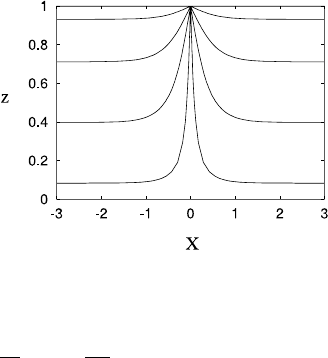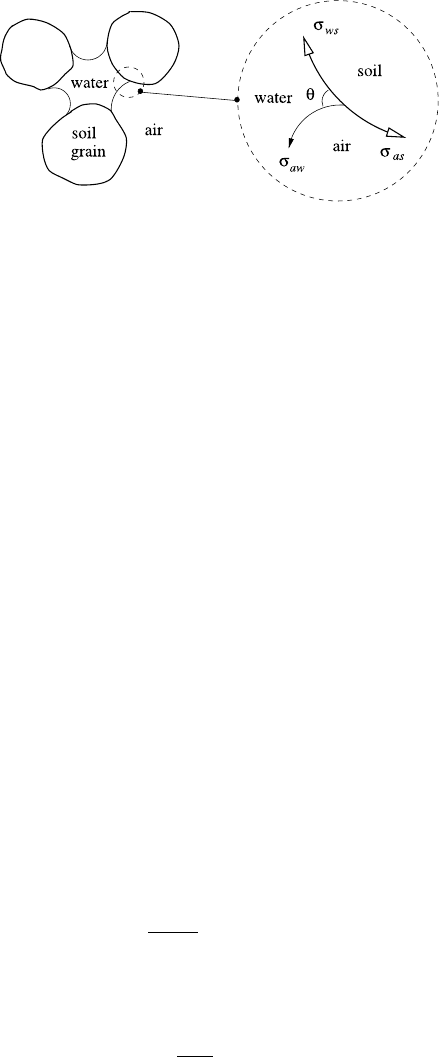Fowler A. Mathematical Geoscience
Подождите немного. Документ загружается.


390 7 Groundwater Flow
where d
p
=[d
p
]mm, and using φ
3/2
/X =10
−3
, g =10 m s
−2
, μ/ρ =10
−6
m
2
s
−2
.
Thus the flow is laminar for d<5 mm, corresponding to a gravel. Only for free flow
through very coarse gravel could the flow become turbulent, but for water percola-
tion in rocks and soils, we invariably have slow, laminar flow.
In other situations, and notably for forced gas stream flow in fluidised beds or in
packed catalyst reactor beds, the flow can be rapid and turbulent. In this case, the
Poiseuille flow balance −∇p =μu/k can be replaced by the Ergun equation
−∇p =
ρ|u|u
k
; (7.7)
more generally, the right hand side will be a sum of the two (laminar and turbulent)
interfacial resistances. The Ergun equation reflects the fact that turbulent flow in a
pipe is resisted by Reynolds stresses, which are generated by the fluctuation of the
inertial terms in the momentum equation. Just as for the laminar case, the parame-
ter k
, having units of length, depends both on the grain size d
p
and on φ. Evidently,
we will have
k
=d
p
E(φ), (7.8)
with the numerical factor E →0asφ →0.
7.1.1 Hydraulic Conductivity
Another measure of flow rate in porous soil or rock relates specifically to the passage
of water through a porous medium under gravity. For free flow, the pressure gradient
downwards due to gravity is just ρg, where ρ is the density of water and g is the
gravitational acceleration; thus the water flux per unit area in this case is just
K =
kρg
μ
, (7.9)
and this quantity is called the hydraulic conductivity. It has units of velocity. A hy-
draulic conductivity of K =10
−5
ms
−1
(about 300 m y
−1
) corresponds to a perme-
ability of k =10
−12
m
2
, this latter unit also being called the darcy.
7.1.2 Homogenisation
The ‘derivation’ of Darcy’s law can be carried out in a more formal way using the
method of homogenisation. This is essentially an application of the method of mul-
tiple (space) scales to problems with microstructure. Usually (for analytic reasons)
one assumes that the microstructure is periodic, although this is probably not strictly
necessary (so long as local averages can be defined).

7.1 Darcy’s Law 391
Consider the Stokes flow equations for a viscous fluid in a medium of macro-
scopic length l, subject to a pressure gradient of order p/ l . If the microscopic
(e.g., grain size) length scale is d
p
, and ε = d
p
/l, then if we scale velocity with
d
2
p
p / l μ (appropriate for local Poiseuille-type flow), length with l, and pressure
with p , the Navier–Stokes equations can be written in the dimensionless form
∇.u =0,
0 =−∇p +ε
2
∇
2
u,
(7.10)
together with the no-slip boundary condition,
u =0onS :f(x/ε) =0, (7.11)
where S is the interfacial surface. We put x =εξ and seek solutions in the form
u =u
(0)
(x, ξ) +εu
(1)
(x, ξ)...,
p =p
(0)
(x, ξ) +εp
(1)
(x, ξ)....
(7.12)
Expanding the equations in powers of ε and equating terms leads to p
(0)
=p
(0)
(x),
and u
(0)
satisfies
∇
ξ
.u
(0)
=0,
0 =−∇
ξ
p
(1)
+∇
2
ξ
u
(0)
−∇
x
p
(0)
,
(7.13)
equivalent to Stokes’ equations for u
(0)
with a forcing term −∇
x
p
(0)
.Ifw
j
is the
velocity field which (uniquely) solves
∇
ξ
.w
j
=0,
0 =−∇
ξ
P +∇
2
ξ
w
j
+e
j
,
(7.14)
with periodic (in ξ) boundary conditions and u = 0onf(ξ ) = 0, where e
j
is the
unit vector in the ξ
j
direction, then (since the equation is linear) we have (summing
over j )
3
u
(0)
=−
∂p
(0)
∂x
j
w
j
. (7.15)
We define the average flux
u=
1
V
V
u
(0)
dV, (7.16)
3
In other words, we employ the summation convention which states that summation is implied
over repeated suffixes, see for example Jeffreys and Jeffreys (1953).

392 7 Groundwater Flow
where V is the volume over which S is periodic.
4
Averaging (7.15) then gives
u=−k
∗
.∇p, (7.17)
where the (dimensionless) permeability tensor is defined by
k
∗
ij
=
w
j
i
. (7.18)
Recollecting the scales for velocity, length and pressure, we find that the dimen-
sional version of (7.17)is
u=−
k
μ
.∇p, (7.19)
where
k =k
∗
d
2
p
, (7.20)
so that k
∗
is the equivalent in homogenisation theory of the quantity φ
2
/X in (7.3).
7.1.3 Empirical Measures
While the validity of Darcy’s law can be motivated theoretically, it ultimately relies
on experimental measurements for its accuracy. The permeability k has dimensions
of (length)
2
, which as we have seen is related to the mean ‘grain size’. If we write
k =d
2
p
C, then the number C depends on the pore configuration. For a tubular net-
work (in three dimensions), one finds C ≈φ
2
/72π (as long as φ is relatively small).
A different and often used relation is that of Carman and Kozeny, which applies to
pseudo-spherical grains (for example sand grains); this is
C ≈
φ
3
180(1 −φ)
2
. (7.21)
The factor (1 −φ)
2
takes some account of the fact that as φ increases towards one,
the resistance to motion becomes negligible. In fact, for media consisting of unce-
mented (i.e., separate) grains, there is a critical value of φ beyond which the medium
as a whole will deform like a fluid. Depending on the grain size distribution, this
value is about 0.5 to 0.6. When the medium deforms in this way, the description
of the intergranular fluid flow can still be taken to be given by Darcy’s law, but
this now constitutes a particular choice of the interactive drag term in a two-phase
flow model. At lower porosities, deformation can still occur, but it is elastic not vis-
cous (on short time scales), and given by the theory of consolidation or compaction,
which we discuss later.
4
Specifically, we take V to be the soil volume, but the integral is only over the pore space volume,
where u is defined. In that case, the average u is in fact the Darcy flux (i.e., volume fluid flux per
unit area).

7.2 Basic Groundwater Flow 393
Table 7.1 Different grain
size materials and their
typical permeabilities
k (m
2
) Material
10
−8
gravel
10
−10
sand
10
−12
fractured igneous rock
10
−13
sandstone
10
−14
silt
10
−18
clay
10
−20
granite
In the case of soils or sediments, empirical power laws of the form
C ∼φ
m
(7.22)
are often used, with much higher values of the exponent (e.g. m = 8). Such be-
haviour reflects the (chemically derived) ability of clay-rich soils to retain a high
fraction of water, thus making flow difficult. Table 7.1 gives typical values of the
permeability of several common rock and soil types, ranging from coarse gravel
and sand to finer silt and clay.
An explicit formula of Carman–Kozeny type for the turbulent Ergun equation
expresses the ‘turbulent’ permeability k
, defined in (7.7), as
k
=
φ
3
d
p
175(1 −φ)
. (7.23)
7.2 BasicGroundwaterFlow
Darcy’s equation is supplemented by an equation for the conservation of the fluid
phase (or phases, for example in oil recovery, where these may be oil and water).
For a single phase, this equation is of the simple conservation form
∂
∂t
(ρφ) +∇.(ρu) =0, (7.24)
supposing there are no sources or sinks within the medium. In this equation, ρ is the
material density, that is, mass per unit volume of the fluid.Atermφ is not present
in the divergence term, since u has already been written as a volume flux (i.e., the φ
has already been included in it: cf. (7.4)).
Eliminating u, we have the parabolic equation
∂
∂t
(ρφ) =∇.
k
μ
ρ∇p
, (7.25)
and we need a further equation of state (or two) to complete the model. The simplest
assumption corresponds to incompressible groundwater flowing through a rigid

394 7 Groundwater Flow
porous medium. In this case, ρ and φ are constant, and the governing equation
reduces (if also k is constant) to Laplace’s equation
∇
2
p =0. (7.26)
This simple equation forms the basis for the following development. Before pur-
suing this, we briefly mention one variant, and that is when there is a compressible
pore fluid (e.g., a gas) in a non-deformable medium. Then φ is constant (so k is con-
stant), but ρ is determined by pressure and temperature. If we can ignore the effects
of temperature, then we can assume p =p(ρ) with p
(ρ) > 0, and
ρ
t
=
k
μφ
∇.
ρp
(ρ)∇ρ
, (7.27)
which is a nonlinear diffusion equation for ρ, sometimes called the porous medium
equation.Ifp ∝ρ
γ
, γ>0, this is degenerate when ρ =0, and the solutions display
the typical feature of finite spreading rate of compactly supported initial data.
7.2.1 Boundary Conditions
The Laplace equation (7.26) in a domain D requires boundary data to be prescribed
on the boundary ∂D of the spatial domain. Typical conditions which apply are a no
flow through condition at an impermeable boundary, u.n =0, whence
∂p
∂n
=0on∂D, (7.28)
or a permeable surface condition
p =p
a
on ∂D, (7.29)
where for example p
a
would be atmospheric pressure at the ground surface. Another
example of such a condition would be the prescription of oceanic pressure at the
interface with the oceanic crust.
A more common application of the condition (7.29) is in the consideration of
flow in the saturated zone below the water table (which demarcates the upper limit
of the saturated zone). At the water table, the pressure is in equilibrium with the air
in the unsaturated zone, and (7.29) applies. The water table is a free surface, and
an extra kinematic condition is prescribed to locate it. This condition says that the
phreatic surface is also a material surface for the underlying groundwater flow, so
that its velocity is equal to the average fluid velocity (not the flux): bearing in mind
(7.4), we have
∂F
∂t
+
u
φ
.∇F =0on∂D, (7.30)
if the free surface ∂D is defined by F(x,t)=0.

7.2 Basic Groundwater Flow 395
7.2.2 Dupuit Approximation
One of the principally obvious features of mature topography is that it is relatively
flat. A slope of 0.1 is very steep, for example. As a consequence of this, it is typi-
cally also the case that gradients of the free groundwater (phreatic) surface are also
small, and a consequence of this is that we can make an approximation to the equa-
tions of groundwater flow which is analogous to that used in shallow water theory
or the lubrication approximation, i.e., we can take advantage of the large aspect ra-
tio of the flow. This approximation is called the Dupuit, or Dupuit–Forchheimer,
approximation.
To be specific, suppose that we have to solve
∇
2
p =0in0<z<h(x,y,t), (7.31)
where z is the vertical coordinate, z = h is the phreatic surface, and z = 0is
an impermeable basement. We let u denote the horizontal (vector) component of
the Darcy flux, and w the vertical component. In addition, we now denote by
∇ =(
∂
∂x
,
∂
∂y
) the horizontal component of the gradient vector. The boundary condi-
tions are then
p =0,φh
t
+u.∇h =w on z =h,
∂p
∂z
+ρg =0onz =0;
(7.32)
here we take (gauge) pressure measured relative to atmospheric pressure. The con-
dition at z =0 is that of no normal flux, allowing for gravity.
Let us suppose that a horizontal length scale of relevance is l, and that the corre-
sponding variation in h is of order d, thus
ε =
d
l
(7.33)
is the size of the phreatic gradient, and is small. We non-dimensionalise the variables
by scaling as follows:
x,y ∼l, z ∼d, p ∼ρgd,
u ∼
kρgd
μl
,w∼
kρgd
2
μl
2
,t∼
φμl
2
kρgd
.
(7.34)
The choice of scales is motivated by the same ideas as lubrication theory. The pres-
sure is nearly hydrostatic, and the flow is nearly horizontal.
The dimensionless equations are
u =−∇p, ε
2
w =−(p
z
+1),
∇.u +w
z
=0,
(7.35)

396 7 Groundwater Flow
with
p
z
=−1onz =0,
p =0,h
t
=w +∇p.∇h on z =h.
(7.36)
At leading order as ε →0, the pressure is hydrostatic:
p =h −z +O
ε
2
. (7.37)
More precisely, if we put
p =h −z +ε
2
p
1
+···, (7.38)
then (7.35) implies
p
1zz
=−∇
2
h, (7.39)
with boundary conditions, from (7.36),
p
1z
=0onz =0,
p
1z
=−h
t
+|∇h|
2
on z =h.
(7.40)
Integrating (7.39) from z =0toz =h thus yields the evolution equation for h in the
form
h
t
=∇.[h∇h], (7.41)
which is a nonlinear diffusion equation of degenerate type when h = 0.
This is easily solved numerically, and there are various exact solutions which
are indicated in the exercises. In particular, steady solutions are found by solving
Laplace’s equation for
1
2
h
2
, and there are various kinds of similarity solution. (7.41)
is a second order equation requiring two boundary conditions. A typical situation in
a river catchment is where there is drainage from a watershed to a river. A suitable
problem in two dimensions is
h
t
=(hh
x
)
x
+r, (7.42)
where the source term r represents recharge due to rainfall. It is given by
r =
r
D
ε
2
K
, (7.43)
where r
D
is the rainfall rate and K = kρg/μ is the hydraulic conductivity. At the
divide (say, x = 0), we have h
x
=0, whereas at the river (say, x = 1), the elevation
is prescribed, h =1 for example. The steady solution is
h =
1 +r −rx
2
1/2
, (7.44)
and perturbations to this decay exponentially. If this value of the elevation of the
water table exceeds that of the land surface, then a seepage face occurs, where water

7.2 Basic Groundwater Flow 397
seeps from below and flows over the surface. This can sometimes be seen in steep
mountainous terrain, or on beaches, when the tide is going out.
The Dupuit approximation is not uniformly valid at x =1, where conditions of
symmetry at the base of a valley would imply that u =0, and thus p
x
=0. There is
therefore a boundary layer near x =1, where we rescale the variables by writing
x =1 −εX, w =
W
ε
,h=1 +εH, p =1 −z +εP. (7.45)
Substituting these into the two-dimensional version of (7.35) and (7.36), we find
u =P
X
,W=−P
z
, ∇
2
P = 0in0<z<1 +εH, 0 <X<∞, (7.46)
with boundary conditions
P =H, εH
t
+P
X
H
X
=
W
ε
+r on z =1 +εH,
P
X
=0onX =0,
P
z
=0onz =0,
P ∼H ∼rX as X →∞.
(7.47)
At leading order in ε, this is simply
∇
2
P = 0in0<z<1, 0 <X<∞,
P
z
=0onz =0, 1,
P
X
=0onX =0,
P ∼rX as X →∞.
(7.48)
Evidently, this has no solution unless we allow the incoming groundwater flux r
from infinity to drain to the river at X =0, z =1. We do this by having a singularity
in the form of a sink at the river,
P ∼
r
π
ln
X
2
+(1 −z)
2
near X =0,z=1. (7.49)
Thesolutionto(7.48) can be obtained by using complex variables and the method
of images, by placing sinks at z =±(2n +1), for integral values of n. Making use
of the infinite product formula (Jeffrey 2004, p. 72)
∞
1
1 +
ζ
2
(2n +1)
2
=cosh
πζ
2
, (7.50)
where ζ =X +iz, we find the solution to be
P =
r
π
ln
cosh
2
πX
2
cos
2
πz
2
+sinh
2
πX
2
sin
2
πz
2
. (7.51)

398 7 Groundwater Flow
Fig. 7.2 Groundwater flow
lines towards a river at X =0,
z = 1
The complex variable form of the solution is
φ =P +iψ =
2r
π
lncosh
πζ
2
, (7.52)
which is convenient for plotting. The streamlines of the flow are the lines ψ =
constant, and these are shown in Fig. 7.2.
This figure illustrates an important point, which is that although the flow towards
a drainage point may be more or less horizontal, near the river the groundwater
seeps upwards from depth. Drainage is not simply a matter of near surface recharge
and drainage. This means that contaminants which enter the deep groundwater may
reside there for a very long time.
A related point concerns the recharge parameter r defined in (7.43). According to
Table 7.1, a typical permeability for sand is 10
−10
m
2
, corresponding to a hydraulic
conductivity of K = 10
−3
ms
−1
,or3× 10
4
my
−1
. Even for phreatic slopes as
low as ε =10
−2
, the recharge parameter r O(1), and shallow aquifer drainage is
feasible.
However, finer-grained sediments are less permeable, and the calculation of r
for a silt with permeability of 10
−14
m
2
(K =10
−7
ms
−1
=3my
−1
suggests that
r ∼1/ε
2
1, so that if the Dupuit approximation applied, the groundwater surface
would lie above the Earth’s surface everywhere. This simply points out the obvi-
ous fact that if the groundmass is insufficiently permeable, drainage cannot occur
through it but water will accumulate at the surface and drain by overland flow. The
fact that usually the water table is below but quite near the surface suggests that the
long term response of landscape to recharge is to form topographic gradients and
sufficiently deep sedimentary basins so that this status quo can be maintained.
7.3 Unsaturated Soils
Let us now consider flow in the unsaturated zone. Above the water table, water and
air occupy the pore space. If the porosity is φ and the water volume fraction per
unit volume of soil is W , then the ratio S =W/φ is called the relative saturation.If

7.3 Unsaturated Soils 399
Fig. 7.3 Configuration of air and water in pore space. The contact angle θ measured through the
water is acute, so that water is the wetting phase. σ
ws
, σ
as
and σ
aw
are the surface energies of the
three interfaces
S = 1, the soil is saturated, and if S<1 it is unsaturated. The pore space of an un-
saturated soil is configured as shown in Fig. 7.3. In particular, the air/water interface
is curved, and in an equilibrium configuration the curvature of this interface will
be constant throughout the pore space. The value of the curvature depends on the
amount of liquid present. The less liquid there is (i.e., the smaller the value of S),
then the smaller the pores where the liquid is found, and thus the higher the curva-
ture. Associated with the curvature is a suction effect due to surface tension across
the air/water interface. The upshot of all this is that the air and water pressures are
related by a capillary suction characteristic function which expresses the difference
between the pressures as a function of mean curvature, and hence, directly, S:
p
a
−p
w
=f(S). (7.53)
The suction characteristic f(S) is equal to 2σκ, where κ is the mean interfacial
curvature: σ is the surface tension. For air and water in soil, f is positive as water
is the wetting phase, that is, the contact angle at the contact line between air, water
and soil grain is acute, measured through the water (see Fig. 7.3). The resulting form
of f(S)displays hysteresis as indicated in Fig. 7.4, with different curves depending
on whether drying or wetting is taking place.
7.3.1 The Richards Equation
To model unsaturated flow, we have the conservation of mass equation in the form
∂(φS)
∂t
+∇.u =0, (7.54)
where we take φ as constant. Darcy’s law for an unsaturated flow has the form, now
with gravitational acceleration included,
u =−
k(S)
μ
[∇p +ρg
ˆ
k], (7.55)
